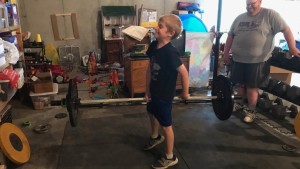Plates in or out-Does it matter?

Leroy Todd performing a one hand deadlift with the weights having been properly loaded facing the inside
By Eric Todd
When I was a lad and began experimenting with weight training, what I had at my disposal was the old plastic clad concrete weights. Nothing fancy, but they did the job for the time being. On those clad weights, one side of the “plate” as identical to the other, so it did not matter which way you slid the plate on, they would match.
When I entered the 8th grade, which at that time was housed at Cameron High School, we had just hired on a new head football coach/PE teacher. He had been a competitive powerlifter, and was quite invested in the weight room, so we got to experience some of his expertise in the weight room. We had some decent equipment at the High School including some cast iron Olympic weight sets. The protocol this instructor taught us was that we were to always load the weights face side in, smooth side out. That was to be done without exception. If it was ever noticed that the plate was loaded the wrong way, the guilty lad would be corrected, and there would be an expectation to fix the mistake.
So, for the rest of my life under the barbell, I have loaded the bar face in, smooth side out. I have noticed at some meets, that is the expectation. For the Heavy Lifts, I would insist upon it, as well as matching plates, since balance of the bar is crucial. I have also witnessed individuals who habitually load plates the other way, and meets where it did not seem to matter to anyone. With my kids now joining me to lift, though, I have taught them to always load the bar face in, smooth side out.
My question to you is, does it matter? Or is it something that certain lifters/promoters are just obsessive about. For instance, I was once training in a gym in which they would search the gym up and down to be sure they had matching tens on each side of the bar. I found it silly, but perhaps there was a method to that madness. I got joshed once by a confederate of mine for searching for two and a half pound plates to go for a PR. He told me if I could be going for 5 more, 10 more (or adding fives instead of 2 1/2s ) would not really make that much difference. And perhaps he is right, since we were not using calibrated weights anyhow. At any rate, I want to hear from you all. Does it matter which way the weights face? Not that you will change my mind, but I am interested. Discussion in the forum.